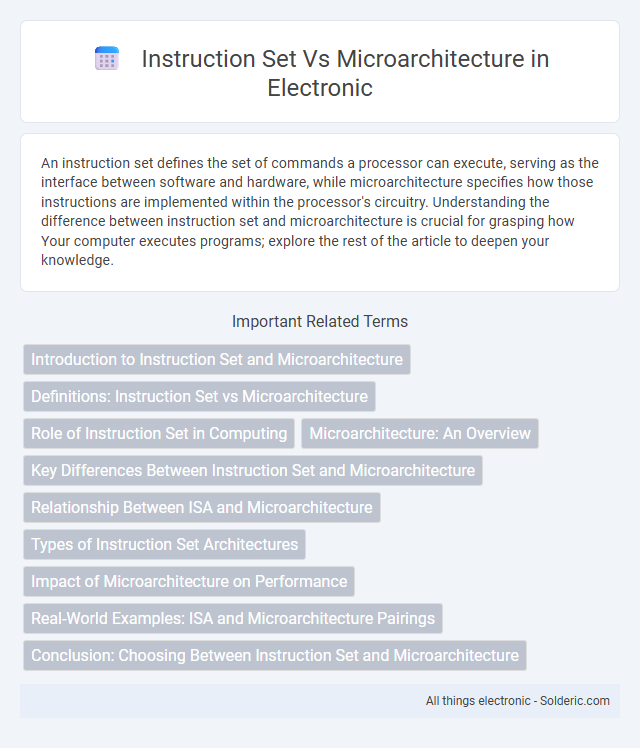An instruction set defines the set of commands a processor can execute, serving as the interface between software and hardware, while microarchitecture specifies how those instructions are implemented within the processor's circuitry. Understanding the difference between instruction set and microarchitecture is crucial for grasping how Your computer executes programs; explore the rest of the article to deepen your knowledge.
Comparison Table
| Aspect | Instruction Set | Microarchitecture |
|---|---|---|
| Definition | Set of machine-level instructions supported by a CPU | Implementation design of the CPU executing the instruction set |
| Purpose | Defines what operations the CPU can perform | Defines how operations are executed and optimized |
| Level | Architectural (ISA) level | Hardware implementation level |
| Examples | x86, ARM, MIPS, RISC-V | Pipeline design, cache hierarchy, execution units |
| Focus | Instruction format, addressing modes, opcodes | Data path, control signals, timing, performance |
| Change Frequency | Rarely changes (stable standards) | Frequently updated for optimization |
| Impact | Compatibility across CPUs | Performance, power efficiency, cost |
Introduction to Instruction Set and Microarchitecture
Instruction set refers to the collection of basic commands that a processor can execute, defining the interface between software and hardware. Microarchitecture describes the implementation details of how a processor interprets and executes those instructions, including components like ALUs, registers, and pipelines. Your understanding of both is crucial for optimizing software performance and designing efficient processors.
Definitions: Instruction Set vs Microarchitecture
Instruction set defines the set of machine-level commands a processor can execute, serving as the interface between software and hardware, dictating how programs control the CPU. Microarchitecture refers to the underlying implementation and design of the processor that executes the instruction set, including components like pipelines, caches, and execution units. Understanding the difference clarifies how Your software commands translate into physical operations within a computer system.
Role of Instruction Set in Computing
The instruction set defines the fundamental commands that a processor can execute, serving as the interface between software and hardware. It specifies the operations, data types, registers, and addressing modes that software developers utilize to write programs. The efficiency and compatibility of computing systems heavily depend on the design and complexity of the instruction set architecture (ISA), influencing both performance and scalability.
Microarchitecture: An Overview
Microarchitecture defines the implementation of a processor's instruction set architecture (ISA) at the hardware level, detailing how instructions are executed through components like pipelines, caches, and execution units. It focuses on optimizing performance, power efficiency, and instruction throughput by organizing the processor's internal structures and data paths. Understanding microarchitecture is crucial for designing processors that balance speed, complexity, and energy consumption while supporting the given instruction set.
Key Differences Between Instruction Set and Microarchitecture
Instruction set architecture (ISA) defines the set of machine-level instructions a processor can execute, serving as the interface between software and hardware. Microarchitecture, on the other hand, refers to the specific implementation of the ISA within a processor, detailing how these instructions are executed using components like pipelines, caches, and execution units. Understanding the key differences between instruction set and microarchitecture helps optimize your software performance by aligning code with the processor's capabilities and design.
Relationship Between ISA and Microarchitecture
The Instruction Set Architecture (ISA) defines the set of commands a processor can execute, serving as a contract between software and hardware, while microarchitecture is the specific implementation of that ISA within a processor. Your software relies on the ISA to ensure compatibility across different microarchitectures, which can vary in design, performance, and efficiency despite supporting the same instruction set. This relationship allows hardware developers to innovate on microarchitectural features like pipelines, caches, and parallelism without changing the underlying ISA visible to software.
Types of Instruction Set Architectures
Instruction Set Architectures (ISAs) define the set of machine-level instructions a processor can execute, shaping the interface between software and hardware. Key types of ISAs include Complex Instruction Set Computing (CISC), which features numerous specialized instructions; Reduced Instruction Set Computing (RISC), emphasizing a smaller, highly optimized set of instructions for faster execution; and Very Long Instruction Word (VLIW), which allows multiple operations to be encoded in a single long instruction word to exploit parallelism. Understanding the distinctions between these ISA types is crucial for microarchitecture design, affecting pipeline complexity, instruction decoding, and overall processor performance.
Impact of Microarchitecture on Performance
Microarchitecture directly influences the performance of a processor by determining how the instruction set architecture (ISA) is implemented through pipeline design, cache hierarchy, and execution units. Variations in microarchitecture enable differences in instruction throughput, latency, and power efficiency despite identical ISAs. Optimizations like superscalar execution, branch prediction, and out-of-order execution significantly enhance performance by effectively managing instruction flow and resource utilization.
Real-World Examples: ISA and Microarchitecture Pairings
The x86 instruction set architecture (ISA) pairs with Intel's Skylake microarchitecture, exemplifying how ISA defines the commands a processor understands, while Skylake's microarchitecture dictates the implementation details optimizing performance and power efficiency. ARM's ISA combined with the Cortex-A72 microarchitecture highlights a design tailored for mobile devices, balancing high throughput with low energy consumption. You can see how different microarchitectures bring unique advantages even when using the same ISA, affecting speed, efficiency, and application suitability.
Conclusion: Choosing Between Instruction Set and Microarchitecture
Selecting between instruction set and microarchitecture depends on design goals and performance requirements. Instruction set architecture (ISA) defines the software-visible interface, ensuring compatibility and guiding compiler optimization, while microarchitecture dictates the physical implementation efficiency affecting speed and power consumption. Prioritizing ISA ensures long-term software support, whereas optimizing microarchitecture enhances hardware performance within that ISA framework.
instruction set vs microarchitecture Infographic

 solderic.com
solderic.com